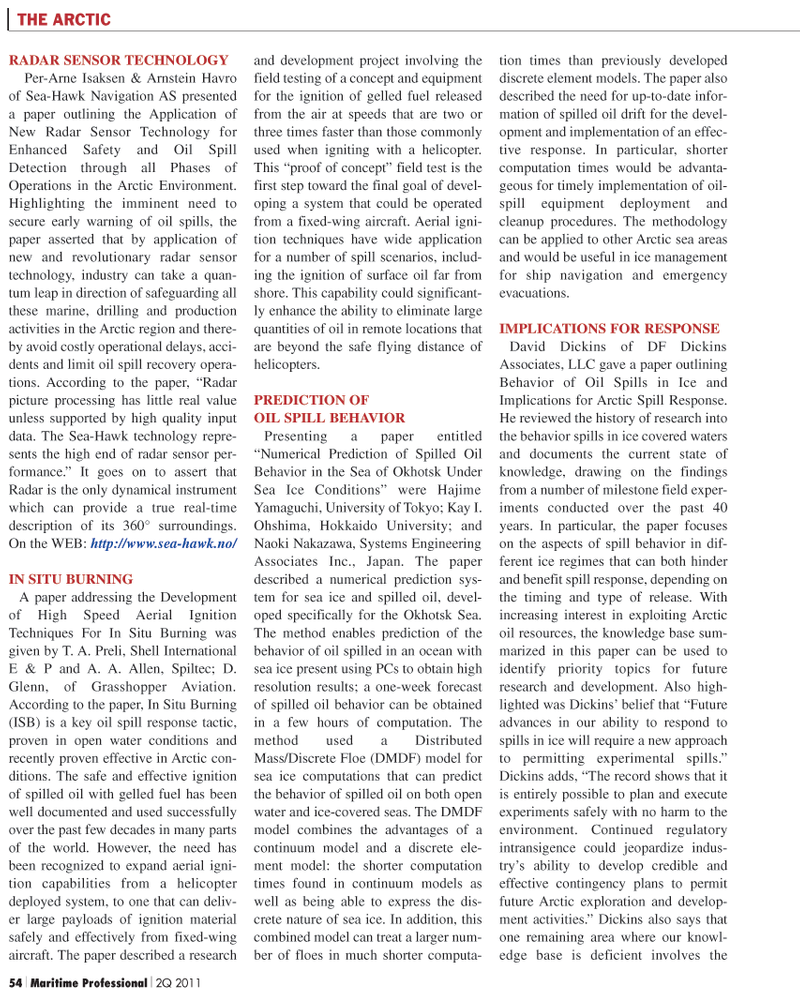
Page 54: of Maritime Logistics Professional Magazine (Q2 2011)
Energy Transportation
Read this page in Pdf, Flash or Html5 edition of Q2 2011 Maritime Logistics Professional Magazine
54 Maritime Professional 2Q 2011
RADAR SENSOR TECHNOLOGY
Per-Arne Isaksen & Arnstein Havro of Sea-Hawk Navigation AS presented a paper outlining the Application of
New Radar Sensor Technology for
Enhanced Safety and Oil Spill
Detection through all Phases of
Operations in the Arctic Environment.
Highlighting the imminent need to secure early warning of oil spills, the paper asserted that by application of new and revolutionary radar sensor technology, industry can take a quan- tum leap in direction of safeguarding all these marine, drilling and production activities in the Arctic region and there- by avoid costly operational delays, acci- dents and limit oil spill recovery opera- tions. According to the paper, “Radar picture processing has little real value unless supported by high quality input data. The Sea-Hawk technology repre- sents the high end of radar sensor per- formance.” It goes on to assert that
Radar is the only dynamical instrument which can provide a true real-time description of its 360° surroundings.
On the WEB: http://www.sea-hawk.no/
IN SITU BURNING
A paper addressing the Development of High Speed Aerial Ignition
Techniques For In Situ Burning was given by T. A. Preli, Shell International
E & P and A. A. Allen, Spiltec; D.
Glenn, of Grasshopper Aviation.
According to the paper, In Situ Burning (ISB) is a key oil spill response tactic, proven in open water conditions and recently proven effective in Arctic con- ditions. The safe and effective ignition of spilled oil with gelled fuel has been well documented and used successfully over the past few decades in many parts of the world. However, the need has been recognized to expand aerial igni- tion capabilities from a helicopter deployed system, to one that can deliv- er large payloads of ignition material safely and effectively from fixed-wing aircraft. The paper described a research and development project involving the field testing of a concept and equipment for the ignition of gelled fuel released from the air at speeds that are two or three times faster than those commonly used when igniting with a helicopter.
This “proof of concept” field test is the first step toward the final goal of devel- oping a system that could be operated from a fixed-wing aircraft. Aerial igni- tion techniques have wide application for a number of spill scenarios, includ- ing the ignition of surface oil far from shore. This capability could significant- ly enhance the ability to eliminate large quantities of oil in remote locations that are beyond the safe flying distance of helicopters.
PREDICTION OF
OIL SPILL BEHAVIOR
Presenting a paper entitled “Numerical Prediction of Spilled Oil
Behavior in the Sea of Okhotsk Under
Sea Ice Conditions” were Hajime
Yamaguchi, University of Tokyo; Kay I.
Ohshima, Hokkaido University; and
Naoki Nakazawa, Systems Engineering
Associates Inc., Japan. The paper described a numerical prediction sys- tem for sea ice and spilled oil, devel- oped specifically for the Okhotsk Sea.
The method enables prediction of the behavior of oil spilled in an ocean with sea ice present using PCs to obtain high resolution results; a one-week forecast of spilled oil behavior can be obtained in a few hours of computation. The method used a Distributed
Mass/Discrete Floe (DMDF) model for sea ice computations that can predict the behavior of spilled oil on both open water and ice-covered seas. The DMDF model combines the advantages of a continuum model and a discrete ele- ment model: the shorter computation times found in continuum models as well as being able to express the dis- crete nature of sea ice. In addition, this combined model can treat a larger num- ber of floes in much shorter computa- tion times than previously developed discrete element models. The paper also described the need for up-to-date infor- mation of spilled oil drift for the devel- opment and implementation of an effec- tive response. In particular, shorter computation times would be advanta- geous for timely implementation of oil- spill equipment deployment and cleanup procedures. The methodology can be applied to other Arctic sea areas and would be useful in ice management for ship navigation and emergency evacuations.
IMPLICATIONS FOR RESPONSE
David Dickins of DF Dickins
Associates, LLC gave a paper outlining
Behavior of Oil Spills in Ice and
Implications for Arctic Spill Response.
He reviewed the history of research into the behavior spills in ice covered waters and documents the current state of knowledge, drawing on the findings from a number of milestone field exper- iments conducted over the past 40 years. In particular, the paper focuses on the aspects of spill behavior in dif- ferent ice regimes that can both hinder and benefit spill response, depending on the timing and type of release. With increasing interest in exploiting Arctic oil resources, the knowledge base sum- marized in this paper can be used to identify priority topics for future research and development. Also high- lighted was Dickins’ belief that “Future advances in our ability to respond to spills in ice will require a new approach to permitting experimental spills.”
Dickins adds, “The record shows that it is entirely possible to plan and execute experiments safely with no harm to the environment. Continued regulatory intransigence could jeopardize indus- try’s ability to develop credible and effective contingency plans to permit future Arctic exploration and develop- ment activities.” Dickins also says that one remaining area where our knowl- edge base is deficient involves the
THE ARCTIC

 53
53

 55
55
